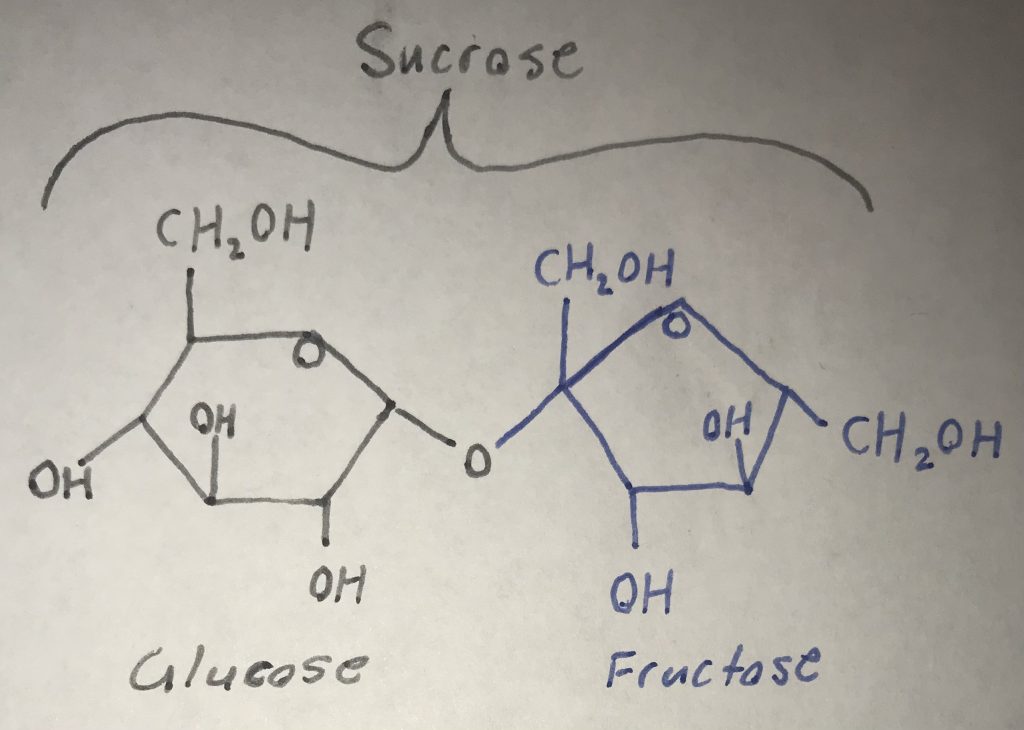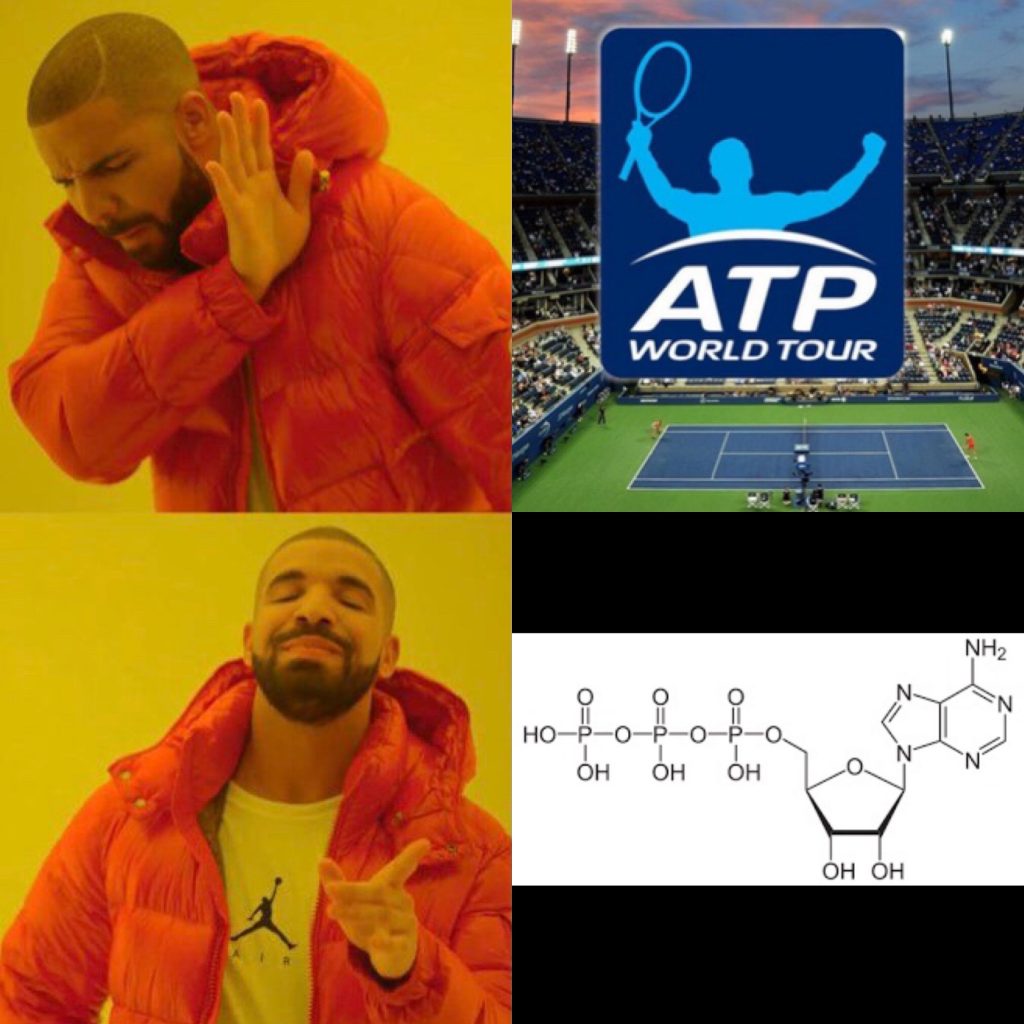Bacterial Cell Diagram
File_000-3BioMolecule: Sucrose

Cell Biology Meme
Everywhere I look these days, there is always something that makes me think of cell biology; and I believe this is solely because of this course and my intended major of marine biology. Whether the things I see are on TV, in a movie, or in sport events, it all causes me to think of biology concepts in some way. This meme in particular was edited by me on my phone when I was watching recordings of ATP Tennis on TV while doing my Smart Biology assignments. My parents enjoy playing tennis and have filled our DVR with tennis programs (I sent this to them as well). Overall, I just thought it was a little funny how tennis and biology are not connected in any way and yet we can still make these types of random connections in our daily lives.

Cell Death and Complex Life
Evan Dodd
Dr. Christina Steel
Bio 293: Cell Biology
1 May 2021
Apoptosis Background
Apoptosis is a normal part of a cell’s life cycle. Cells are produced, perform their function, and then are eliminated when they have stopped serving their purpose. Until now, apoptosis was thought to only occur in large, multicellular organisms such as animals. However, certain species of algae have recently been found to also perform apoptosis as well. There are several organelles commonly found in algae species that perform certain roles in apoptosis.
Obviously, as the organism’s DNA is stored here, the nucleus plays an important role in apoptosis in algae. The events that take place in the nucleus during apoptosis include changes such as the cleavage and fragmentation of DNA, changes to nuclear polypeptides, chromatin condensation, nuclear shrinkage, as well as apoptotic body formation (Rogalińska, 2002).
Algae Background
Algae can have both mitochondria and chloroplasts, and both play roles in the programmed cell death of the algae. Mitochondria activates apoptosis through different mechanisms by releasing various cytotoxic proteins. It also activates caspase proteases that are able to dismantle cells via the “caspase cascade”(Wang and Youle, 2009). Similarly to mitochondria, chloroplasts act as an additional energy transducing compartment and a reactive oxygen species (ROS) generating compartment within the cell (Ambastha, Tripathy, and Tiwari, 2015; Doyle, Diamond, and McCabe, 2010).
Pyrenoids are usually found within the chloroplasts in algae cells. Although their main function is to act as centers of carbon dioxide fixation, they may play a role in apoptosis alongside the chloroplast, though very little is known about this.
Types of Algae Examined
We are also interested in 4 types of algae: Pandorina, Volvox, Chlorella, and Rhodochorton. Pandorina is a multicellular genus of algae though it is only made up of between 16 – 32 individual cells. It is typically spherical in shape with a large chloroplast located in the middle along with pyrenoids. They can usually be found in freshwater (Wikipedia contributors, 2021; Guiry, 2002).
Another genus, Volvox, is much more multicellular in that it is composed of up to 50,000 cells in a spherical shape with a single chloroplast and pyrenoid per individual cell. Volvox also has a couple flagella attached to each cell to propel the algae through its freshwater environments (Wikipedia contributors, 2021; The Editors of Encyclopaedia Britannica, 2018).
Chlorella, unlike the other genuses, are single celled organisms that don’t even have flagella to propel themselves. These cells are highly photosynthetic as they have a large chloroplast and a pyrenoid as well. It can be grown either in freshwater, marine, or even soil (Wikipedia contributors, 2021).
The last genus of algae is the Rhodochorton. It is quite special as it is the only red algae we will be discussing. It will usually be found near caves in marine environments as they prefer low-lighting, though one or two freshwater species have been discovered. Rhodochorton are multicellular with cells forming branches or webs. They have chloroplasts but no pyrenoids (Wikipedia contributors, 2020; Guiry, 1996).
Current Research
In order to examine further how algal cells change after programmed death, we will be assessing the research conducted in an already published journal, Experimental Taphonomy of Organelles and the Fossil Record of Early Eukaryote Evolution. In the study conducted, the researchers obtained the algal samples from Sciento.co.uk, identified and photographed them, and then euthanized the colonies in 300 mM β-mercaptoethanol (BME) for approximately 24 hours in order to prevent cellular digestion via their own enzymes. The colonies were allowed to decay for 6 weeks in either fresh water (for the green algae) or seawater (only for the Rhodochorton). The researchers also controlled for the effects of aerobic microbial activity by conducting simultaneous experiments under two different conditions, oxic and anoxic. They found that there was almost no difference in the rates of decay between the groups (Carlisle, et al., 2021).
The researchers were also looking for several key changes within the cells. They examined nucleus visibility, chloroplast thinning and collapsing, pyrenoid visibility, as well as the overall collapse of the cell.
The quickest to completely collapse was Pandorina. This species showed the quickest rates of chloroplast deformation as well as total overall cellular collapse. The colonies of Volvox displayed signs of decay shortly afterwards as their chloroplasts began thinning around the same time as Pandorina. It is important to note, however, that the chloroplasts of these 2 species appeared quite resilient to decomposition as they remained mostly intact for all of the 6 weeks, though their membrane was full of holes and quite thinned. However, the pyrenoids within the chloroplasts seemed to disappear within the first 3 weeks which left the chloroplast deformed early on (Carlisle, et al., 2021).
The only unicellular species, Chlorella, was actually among the slower species to decay. Though their pyrenoids and chloroplasts degraded similarly to the first 2 species mentioned, they showed the highest retainability of their nucleus as most were still visible, with no apparent damage, after the full 6 week trial (Carlisle, et al., 2021).
Contrast to the other species, the red Rhodochorton had their chloroplasts degrade and collapse at a much greater rate. It may be important to note that these were the only species to not possess pyrenoids. Whether or not that has an impact may be a topic for discussion.
Overall, looking now at the photos taken of the algal groups throughout their decay, the green algae (contrast to red algae Rhodochorton) seemed to retain most of their chloroplasts after the full 6 weeks, though with very noticeable signs of distress and deformation. Many of the multicellular colonies of algae also seemed to break apart after a few days and some even formed misshapen clumps. The nuclei of all species seemed to be the most consistent in appearance as they remained intact for the full 6 week period (Carlisle, et al., 2021).
Fossilization
By examining the images of plant fossils, as well as the results of the study, we can clearly observe that some organelles are preserved in fossil records. Organelles such as the nuclei and the chloroplasts have remained mostly intact in many of the images of fossils in the journal. This evidence, as well as their experimental results, strongly supports the authors’ generalization that not only do some organelles persist weeks after cell decay, but they can even be preserved over long periods of time within plant fossils.
References:
Rogalińska M. (2002). Alterations in cell nuclei during apoptosis. Cellular & molecular biology letters, 7(4), 995–1018.
Wang, C., & Youle, R. J. (2009). The role of mitochondria in apoptosis*. Annual review of genetics, 43, 95–118. https://doi.org/10.1146/annurev-genet-102108-134850
Ambastha, V., Tripathy, B. C., & Tiwari, B. S. (2015). Programmed cell death in plants: A chloroplastic connection. Plant signaling & behavior, 10(2), e989752. https://doi.org/10.4161/15592324.2014.989752
Doyle, S. M., Diamond, M., & McCabe, P. F. (2010). Chloroplast and reactive oxygen species involvement in apoptotic-like programmed cell death in Arabidopsis suspension cultures. Journal of experimental botany, 61(2), 473–482. https://doi.org/10.1093/jxb/erp320
Wikipedia contributors. (2021, March 10). Pandorina. Retrieved April 04, 2021, from https://en.wikipedia.org/wiki/Pandorina
Guiry, M. (2002, April 11). Pandorina BORY, 1826. Retrieved April 04, 2021, from https://www.algaebase.org/search/genus/detail/?tc=accept&genus_id=43494&-session=abv4:AC1F228909de53648BTut7B0E1AA
Wikipedia contributors. (2021, March 09). Volvox. Retrieved April 04, 2021, from https://en.wikipedia.org/wiki/Volvox#:~:text=Volvox%20is%20a%20polyphyletic%20genus,Antonie%20van%20Leeuwenhoek%20in%201700.
The Editors of Encyclopaedia Britannica. (2018, November 16). Volvox. Retrieved April 04, 2021, from https://www.britannica.com/science/Volvox
Wikipedia contributors. (2021, March 09). Chlorella. Retrieved April 04, 2021, from https://en.wikipedia.org/wiki/Chlorella
Wikipedia contributors. (2020, October 01). Rhodochorton. Retrieved April 04, 2021, from https://en.wikipedia.org/wiki/Rhodochorton
Guiry, M. (1996, March 30). Rhodochorton purpureum (Lightfoot) Rosenvinge 1900. Retrieved April 04, 2021, from https://www.algaebase.org/search/species/detail/?species_id=7
Carlisle, E. M., Jobbins, M., Pankhania, V., Cunningham, J. A., and Donoghue, P. C. (2021). Experimental taphonomy of organelles and the fossil record of early eukaryote evolution. Science Advances, 7(5). doi:10.1126/sciadv.abe9487
End-of-Term Reflection
This course has greatly helped me understand more about the inner workings of cellular functions. I am greatly interested in the field of marine biology, especially algae and coral reefs. Both are of paramount importance to humans as algae is the largest producer of the oxygen we breathe as well as a carbon sink; and coral reefs are one of the most productive marine ecosystems on Earth. To be able to learn more about one of those things this semester (algae cell biology) was very interesting to me. Learning more about their cellular processes and decomposition is going to be a large field of study for me, especially as humans continue to look for more alternative fuel sources such of biofuels.